Month 11:15, Week 2:7 (Shibi'i/Sukkot), Year:Day 5945:310 AM
2Exodus 8/40
Gregorian Calendar: Monday 17 January 2022
Book of Revelation VI
The Ancient of Days & Son of Man
(Revelation 1:9-20)
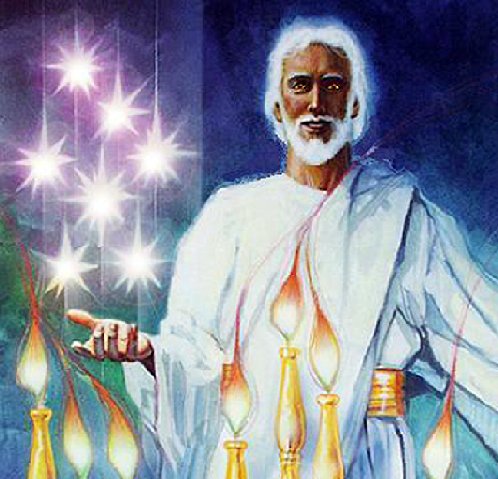
Continued from Part 6
This sermon is dedicated to my mother-in-law, affectionally known by me as 'Ma', who passed away two days before on Saturday 15 January 2022 and is now together with Yah'shua (Jesus), her parents, husband and two sons. Check the Heaven website to learn more about the next world.
Introduction
Shabbat shalom kol beit Yisra'el and Mishpachah and welcome back to the sixth part on our study of the Book of Revelation. Last week we looked at the first 8 verses of Chapter 1 and today we are going to look at the remaining 11.
For Whom the Message
We have established that the message of the Book of Revelation is specifically to the seven assembles or congregations (churches) of the Roman Province of Asia (today in western Turkey), the 'territory', 'apostolic field' or 'bishopric' the apostle John was responsible for spiritually fathering, and that these are a type of the Body of Christ throughout the entire Messianic Community both then and in all æons of ages of time including our own, seven being the number of completion and therefore the full compliment of the saved. There are important things that we can learn from these qodeshim (saints, set-apart ones), their strengths and weaknesses. And though attempts have been made to prophetically represent these seven congregations as types of seven imaginary historical periods of Christianity from that time to the present, it is far more likely what we have here is a representative sample of the kinds of believers that are to be found at all times: the true and faithful, the nominal and the outright lawless.
Two Controversial but Important Doctrines Examined
We focussed on two controversal doctrines last week - controversial for traditional Christendom but common knowledge in John's time - namely, that the Ruach haQodesh or Holy Spirit is female and that 'She' consists of Seven Persons, in effect, our Heavenly Mother, whose specialised activities may be understood in the way She operates in the seven annual festivals from Pesach (Passover) to Sukkot (Tabernacles), and specifically in what these now represent in the New Covenant of Christ. We also looked at the Aramaic word MarYa and saw that it points to Yah'shua (Jesus), the Son of Elohim (God), as the 'Lesser Yahweh' in the Elohimhead (Godhead), forcing us to carefully rethink the claims to allegiance of the Catholic Trinitarian dogma.
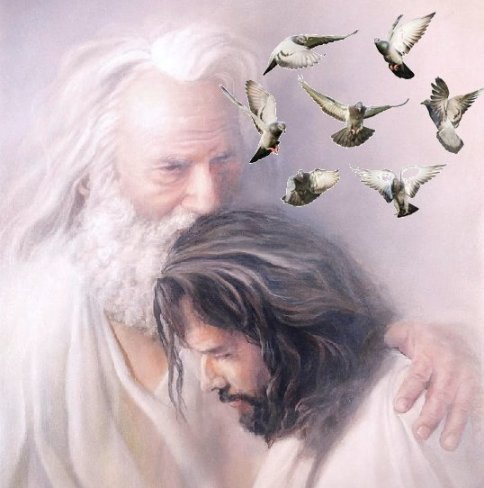 Two Apocaplyse doctrines challenge Trinitarian creeds
Two Apocaplyse doctrines challenge Trinitarian creeds
Kings, Priests and Clouds
Two things we didn't cover last week (because I hope to cover these thoroughly later on in this course) were:
- 1. An examination of verses 6 & 7 where John speaks of true believers being made "kings and cohenim (priests) to His Elohim (God) and Father" (Rev.1:6, NKJV) or "a Kingdom of Cohenim (Priests)" (HRV) (a description of the rôle of the Elect Remnant in the Millennium as rulers of the nations): and
- 2. "He is coming with clouds, and every eye will see Him, even they who pierced Him. And all the tribes of the earth will mourn because of Him" (Rev.1:7, NKJV). More about "clouds" as faithful witnesses (Heb.12:1) another time which affects the way the rapture doctrine is understood (and more usually, misunderstood).
Revelation 1:9-20
So let's get into today's text which like last week's is jam-packed with spiritual gems:
"9 I, John, both your brother and companion in the tribulation and kingdom and patience of Yah'shua the Messiah (Jesus Christ), was on the island that is called Patmos for the Davar Elohim (Word of God) and for the testimony of Yah'shua the Messiah (Jesus Christ). 10 I was in the Ruach (Spirit) on the Master's Day ('Day of the Lord') ('first day of the week' - HRV or the 'Day of Yahweh' - RSTNE) (Ac.20:7; 1 Cor.16:2 or Is.13:6.9; Mal.4:5, etc.), and I heard behind me a loud voice, as of a trumpet ('shofar' - HRV), 11 saying, 'I am the Alef (Alpha) and the Taw (Omega) (Tav in modern Hebrew), the First and the Last,' and, 'What you see, write in a book (scroll) [1] and send it to the seven assemblies (churches) which are in Asia: to Ephesus, to Smyrna, to Pergamos (Pergamum), to Thyatira, to Sardis, to Philadelphia, and to Laodicea.'
"12 Then I turned to see the voice that spoke with me. And having turned I saw seven golden lampstands ('menorahs' = 7-armed candlearbres - HRV, JNT/CJB; 'candlesticks' - KJV), 13 and in the midst of the seven lampstands ('menorahs' - HRV, JNT/CJB; 'candlesticks' - KJV) (Zech.4:2) One like the Son of Man (Dan.7:13; 8:17), clothed with a garment ('ephod' - HRV) down to the feet and girded about the chest with a golden band (Ex.28:4; 29:5). 14 His head and hair were white like wool, as white as snow (Dan.7:9; Is.1:18), and His eyes like a flame of fire (Rev.4:6); 15 His feet were like fine brass (Dan.7:9; 10:5-6) ['of Lebanon' - HRV), as if refined in a furnace, and His voice as the sound of many waters ('streams of mayim' - RSTNE) (Dan.10:6; Ezek.1:24; 43:2); 16 He had in His right hand seven stars, out of His mouth went a sharp two-edged sword ('ruach' = spirit; alt. 'sharp (Heb.4:6) spear ('fervent spirit' - Crawford MS & AENT)' [2]) (Is.11:4; 49:2; cp. Rev.2:12,16; 6:8; 19:15,21), and His countenance was like the sun shining in its strength.
"17 And when I saw Him, I fell at His feet as dead (Rev.4:10; 5:8; 7:11; 19:10; 22:8). But He laid His right hand on me, saying to me, 'Do not be afraid; I am the First and the Last (Rev.1:8; cp. Is.44:6; 48:12). 18 I am He who lives ('the Living One' - NIV) (Josh.3:10; Ps.42:2; 84:2), and was dead, and behold, I am alive forevermore ('le-olam-va-ed' - RSTNE). Amen. And I have the keys of Hades ('Sheol' - HRV) and of Death (Mt.16:8).
"19 Write the things which you have seen, and the things which are, and the things which will take place after this. 20 The mystery of the seven stars which you saw in My right hand, and the seven golden lampstands ('menorahs' - HRV, JNT/CJB): The seven stars (cp. Rev.22:16; Num.24:17; Job.36:7; Dan.12:3; 1 Cor.15:41; Jude 13; Rev.9:1) are the angels ('messengers' - HRV; 'teaching overseers' - RSTNE) of the seven assemblies (churches), and the seven lampstands which you saw are the seven assemblies (churches)" (Rev.1:9-20, NKJV).
Three Themes
Once again, the seven Asian assemblies are highlighted as well as indivividually named. We'll be looking at each of these in turn when we come to chapters 2 & 3. At once we find John reminding his readers of the three pivotal themes of this book that both inform the true talmid (disciple) of what to expect as a follower of Yah'shua (Jesus) and how they form an integral part of spiritual growth and character development:
- 1. Suffering (tribulation) (2:9-10:22; 7:14);
- 2. Kingdom Implementation (11:15; 12:10; 16:10; 17:12,17-18); and
- 3. Learning Patient endurance (2:2-3,19; 3:10; 13:10; 14:12).
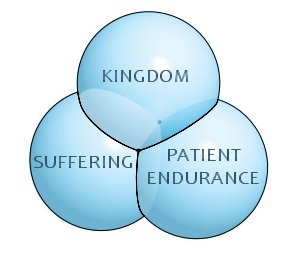
The Path to Perfection
This threefold witness of the Book of Revelation is important - 3 being the number of perfection - because it informs us as to what Yah'shua (Jesus) actually and practically meant when, in the context of loving and praying for your enemies when they persecute you, He issued the mitzvah (commandment):
"Be perfect, therefore, as your heavenly Father is perfect" (Matt 5:48, NIV).
Perfection, then, comes through suffering for righteousness' sake, walking the Kingdom way (by living the Torah the way Yah'shua/Jesus revealed it in its fullness), and enduring patiently all the trials and vicissitudes of life, which can only be done through proactive emunah (faith). This is very different to the false Gnostic way of pursuing salvation through knowledge.
Creatures of Time
But we also see, in these first verses, another threefold division, this time of the whole Book of Revelation itself and of prophetic history generally:
- 1. 'What you have seen' (Rev.1);
- 2. 'What is now' (Rev.2-3; and
- 3. 'What will take place later' (Rev.4ff.).

This both reminds us that we are creautures of time as well as of the importance of history - the story thus far told in which we are called to participate, the importance of being firmly rooted in the present - in reality, and of the hope of the promise of the future, which is prophecy. And though the spiritual may be said to be timeless, it is important to understand that we were designed to live in time and physical space and not to try and escape it as gnostics and others do. And whilst all but the last generation who are alive when Christ returns shall, in death, pass into the world of disembodied spirits at death, this is not the final destination, but a kind of resting station prior to returning with Christ to live on the earth once again in the Millennial Kingdom world. All of these things the second half of the first chapter of the Book of Revelation reminds us of, so that we maintain a correct persepctive of why we are here and why we must experience difficulties in mortality.
The Suffering Prisoner Bears Witness
We need to remember John was a prisoner when he saw the visions of this book and wrote them down. According to Eusebius (265-340), John was released from the Roman penal colony on Patmos under the emperor Nerva (96-98) who succeeded Domitian. Recall that Domitian, like Nero before him, was an active persecutor of Christians/Messianics. This is, by the way, one of the pieces of evidence that makes a later dating of this book to the 90's and not the earlier proposed date of the 70's more compelling. Eusebius is known as 'the father of [early] church history', a reputation justly earned, we hope, because of his accurate gathering of data even though, it must be remembered, he wrote his works two centuries after the events described, long after the first-hand witnesses were dead and gone. Historians like Luke, therefore, who knew and interviewed the living witnesses of the events that he records, must be regarded as more accurate and reliable. So much gets lost and distorted over time. John's sufferings make what he describes in his Apocalypse all the more relevant to us, his readers. He is not an armchair navi (prophet). He's not a theoretician but is living what he preaches, a reminder that Christianity isn't just about 'talking' but about 'walking'.
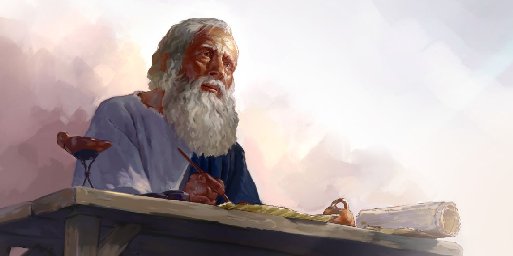 John the prisoner in the Roman penal colonly on Patmos writes Revelation
John the prisoner in the Roman penal colonly on Patmos writes Revelation
The Emptiness of Merely Propositional Religion
Given how important the Kingdom (i.e. Gospel living, discipleship) is in the last book of the Messianic Scriptures (New Testament) and how important it is in the first four books (the Four Gospels), we must surely wonder at how (and why) this subject has become so de-emphasised in Evangelical Christianity which now lays its stress almost entirely on Salvation. The two are equally important. The saved must be diligently discipled because, amongst other things, the lifestyle we live is a pretty good indicator of just how saved we really are. We are what we do, not only what we say, another reason why physical existence is important. Believing and teaching, for example, the doctrine of Justification by Faith means absolutely nothing unless we are seen being justified by faith by our works! Talking is the easy part. The doing is what stretches and makes (or breaks) us. Having a correct mental understanding of the doctrine of salvation is irrelevent unless we are visible witnesses of what 'being saved' actually looks like in practice. In other words, propositional religion is far from the testimony of the Book of Revelation: like the Book of Acts, it's all about true religion in action (1 Tim.5:4; Jas.1:26-27).
Kingdom Living, Persecution and Patient Endurance
Alas, not everyone lives a Torah, commandment-keeping, holiness lifestyle. People tend to 'pick and choose' what they like of the mitzvot (commandments) and reject the rest, taking refuge in the false doctrine of 'Once Saved, Always Saved' in self-justification for wanton, habitual sinning. This typically includes their embracing other false doctrines like the 'Rapture' myth, hoping they will escape the worst of persecution in physical time and space, failing to understand that persecution, however negative, also has the positive and desirable effect of developping "patient endurance" (Rev.1:9; 13:10; 14:12). How will we otherwise ever develop "the patience of Yah'shua the Messiah (Jesus Christ)" (1:9) that is a hallmark of this book? Not everyone who claims to be a Christian or Messianic is spiritually regenerated or born-again. In fact, the vast majority the professing believers of Christendom are not, as their lives painfully demonstrate. So as we read the Book of Revelation we need to be reminded of the close link between salvation and kingdom living. Faith without the works to prove it is always dead (Jas 2:26).
What is the 'Day of the Lord'?
Let's rejoin today's text at verse 17. John's opening vision is his prophetic commission and came to him while He was filled with the Ruach haQodesh (Holy Spirit) on what the NKJV calls the 'Day of the Lord' which in the Greek is the Day of the kurios. Because we don't know whether kurios here refers to the 'Lord' Yah'shua (Jesus) or to the 'LORD' 'Yahweh', it's impossible (using Greek alone) to absolutely know whether this is referring to Resurrection Day (the first day of the week, the first New Covenant Yom haBikkurim - Day of Firstfruits) (HRV), to the seventh day Sabbath, or to the 'Day of Yahweh', a Hebrew idiom for the entire period of time from Yom Teruah (Day of Trumpets) to Yom haKippurim (Day of Atonements/Judgment) and beyond up to Sukkot (Tabernacles) when Yahweh judges the whole earth (RSTNE). Since the the major part of the Book of Revelation concerns just this - Judgment - then there is a good chance the third explanation is the primary meaning (2 Pet.3:1-14). Then, in a secondary sense, it's a choice between the 1st and 7th days of the week. Unfortunately the Aramaic doesn't make this clear either.
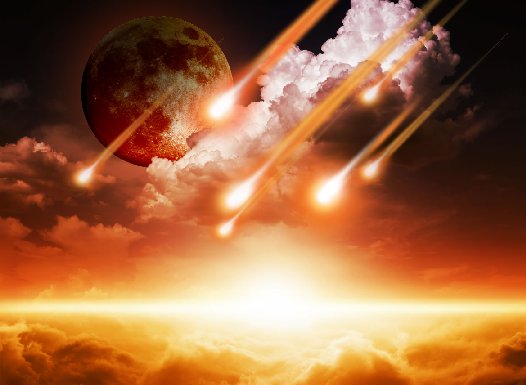 The Book of Revelation is mostly about the judgment Day of Yahweh
The Book of Revelation is mostly about the judgment Day of Yahweh
Echoes of Daniel, the Ancient of Days & Son of Man
A loud Voice from Heaven tells John to write an account of what he is about to see and send it to the seven congregations over which he has pastoral oversight. When he turned to see the source of the voice, he saw the glorified Messiah whom he proceeds to descibe in familiar language drawn from Daniel 7:9,13 and 10:5-6 with which he must have made an immediate association:
"As I looked, thrones were set in place, and the Ancient of Days (Yahweh the Father, the Greater Yahweh - Is.43:13) took His seat. His clothing was as white as snow; the hair of his head was white like wool. His throne was flaming with fire, and its wheels were all ablaze (Ezek.1:16-21; 3:13; 10:2,6,9,11-13,16,19; 11:22). A river of fire was flowing, coming out from before Him. Thousands upon thousands attended Him; ten thousand times ten thousand stood before Him. The court was seated, and the books (scrolls) were opened...In my vision at night I looked, and there before me was One like a Son of Man (Yahweh the Son, Yah'shua/Jesus, the Lesser Yahweh), coming with the clouds of heaven (Heb.12:1). He approached the Ancient of Days and was led into His presence. He was given authority (Mt.28:18; cp.Tit.2:15), glory and sovereign power; all peoples, nations and men of every language worshiped Him. His dominion is an everlasting dominion (Ps.145:13; Dan.7:27) that will not pass away, and His kingdom is one that will never be destroyed" (Dan.7:9-10,13-14, NIV).
"On the twenty-fourth day of the first month, as I was standing on the bank of the great river, the Tigris, I looked up and there before me was a man dressed in linen, with a belt of the finest gold around his waist. His body was like chrysolite, His face like lightning, His eyes like flaming torches, His arms and legs like the gleam of burnished bronze, and His voice like the sound of a multitude" (Dan.10:4-6, NIV).
The Son of Man Identified
Can you see why John's mind would immediately have turned to these passages as he saw his vision? In our text today, the apostle describes the Saviour as "One like the Son of Man" standing among seven golden lampstands or menorahs recalling the seven-armed candlearbres in the Temple. The figure is majestic, both royal and divine, as John falls at His feet, showing his awe and tremendous respect, worshipping the Son as the Lesser Yahweh. He was clothed in the Cohen Gadol's (High Priest's) long ephod girt around the waiste with a golden belt. The Master's hair was white like wool, reminding one of the hoary head of an elder, depicting wisdom and dignity (Lev.19:32; Prov.16:31). His eyes were like fire, indicating His pentrating insight (Rev.4:6). What a sight that must have been!
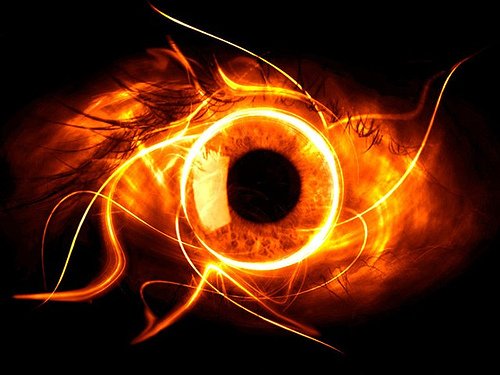 "His eyes blazed like fire" (Revelation 1:14, J.B.Phillips)
"His eyes blazed like fire" (Revelation 1:14, J.B.Phillips)
Messiah Like the Father
This is no longer the young mortal Messiah of the Gospels but the Elohim/God-Man now resurrected and glorified as He was before His incarnation, reminding one of His Father, the 'Ancient of Days', for He is Himself father figure like the Heavenly Father Himself, being the spiritual father of many (Is.9:6). Indeed we're looking at Yahweh Himself, the Lesser Yahweh, to be precise. He carries the sword of divine judgment (Is.49:2; Heb.4:12) which would have resembled a long Thracian sword of that time period, its length symbolising the far reach of His judgment from which none may successfully hide.
Eternal Father, Eternal Son
He describes Himself in eternal terms, "the first and the last", "the beginning and the end", the "Alef and Taw", the "Alpha and Omega", the "A and the Z", no mere man but Divine - Elohim (God) Himself using language that would immediately cause someone familiar with the Tanakh (Old Testament) to easily associate Him with Isaiah's strongly monotheistic vision of the One Elohim (God) (Is.41:10-14; 43:12; 44:6; 48:12). This passage proves incontroveribly that our Master "shares in the power, the rule, the glory and the being of the one true Elohim (God)" [3]. That is the principle witness of both this section of the chapter and of the whole of the Prologue that is Chapter 1. This is essential truth, doctrine that we can never compromise on. For as Yahweh the Father Himself bears witness through the navi (prophet) Isaiah:
"Listen to me, O Jacob,
Israel, whom I have called:
I (Yahweh) am He;
I am the first and I am the last (Rev.1:17; 2:8; 22:13)"
(Isa.48:12, NIV).
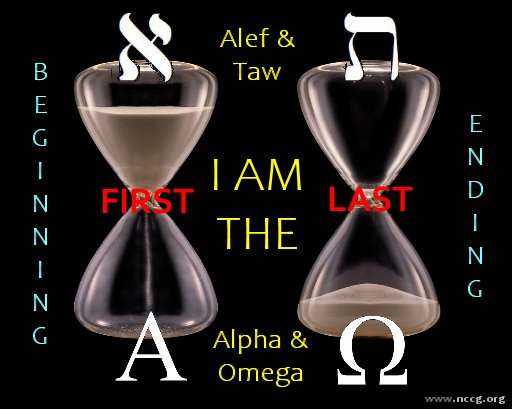 The eternal nature of Deity
The eternal nature of Deity
'To the Angel of...'
In the next two chapters that we will begin to cover next week, Yahweh addresses a message to each of the seven congregations in the Roman Province of Asia with this instruction: "To the angel (aggelos) of the assembly (congregation, church) of..." and then names the congregation (Rev.2:1,8,12,18; 3:1,7,14). So let me leave you with a set of questions: Who are the "angels" of these 7 congregations? There are only three possible explanations. Each 'angel' is either
- 1. A supernatural malak, the 'guardian angel' with oversight over each congregation
- 2. A local minister (like the pastor); or
- 3. A personification of the prevailing spirit of each church.
Angels Have Greater Authority Than Man...for Now
Why would Yahweh ask a navi (prophet) and ro'eh (seer) like the apostle John to deliver a message to an invisible supernatural being? Since when has man ever been ordered to instruct an angel - to pass on a message from the Creator? Yahweh has always done that job Himself. Why? Because in this particular æon or age the malakim (angels) are in higher authority than man (Heb.2:7,9)...the rôles aren't reversed until after the resurrection! Someone with less authority never instructs one who has greater authority with a divine message from Heaven! It is the malakim (angels) who relay messages from Yahweh to mortals. And if, as some claim, what is meant by 'angel' here is merely the personification of a particular prevailing 'spirit' or attitude, how do you then go about instructing the 'personification of a prevailing spirit'? Neither proposition makes any sense.
The 'Angels' or 'Messengers' are Pastors
However, since the Hebrew word malak can either refer to a supernatural or a human messenger (the correct meaning being knowlable only from the context), which the Greek agellos translates (never mind that word's pagan associations), then the 'seven angels' can only be the seven presiding ministers, overseers, fathers or pastors of these congregations. John writes to each pastor or presiding elder, then each pastor reads out the message to his particular congregation. A simple chain of authority. Nothing more. We who are pastors or leaders in the home or local assembly therefore have the calling to read John's Apocalypse out aloud to our congregations and families, even as I am doing today. And though, like I have said, it was common practice in ancient Israel and the early Messianic Community (Church) to read out Scripture aloud anyway, which is still done today, only in this book are we specifically commanded to! Once spoken out aloud and heard, there is a certain finality to the message: 'once delivered, always delivered'!
The Cosmic Lamb of Elohim
A few last thoughts to finish today's message particularly in the light of the accelerating totalitarianism and ongoing threats of war. What John saw was spectacular and overwhelming. Only a tiny handful of the nevi'im (prophets) ever saw a vision of Elohim (God) as he did - Moses, Isaiah, Ezekiel and Daniel being perhaps the most memorable examples. The language is spectacular, with comparisons to the heavenly bodies. His eyes were like flaming fire, His feet, burnished brass, his voice like thundering waters, in His right hand were seven stars, and His face shone like the sun in full blaze, reminding us of Malachi 4:2 - "But for you who revere My name, the sun of righteousness will rise with healing in its wings" (NIV). You never forget an experience like that and sometimes it is easy to forget the kind of glory that surrounds the Lamb of Elohim (God).
Experiencing the Glory
Now we may not experience His glory as the nevi'im (prophets) of old did but we can, and should ask, to experience that glory. If Moses, the faithful servant, could ask, "Please, show me Your glory" (Ex.33:18, NKJV) and have his request granted, then surely Yahweh's faithful servants in every age are entitled to do the same, and He will do so in some form or another tailor-made to your specific needs. He did to me in 1977, And, no, you might be surprised to learn, it was not in the form of a vision - I didn't see anything in that moment - but I most definitely felt it in an overwhelming and never-to-be-forgotten way. And I would rather feel His presence than see it in a vision any time! (See A Glimpse into Heaven).
Between Snuggliness and Total Prostration
For so many people including, alas, many professing believers, Yah'shua (Jesus) is just some far away historical figure from the first century...or if you are a sceptic, some fantasy. For millions past and present, Yah'shua (Jesus) is someone with whom we can establish a personal relationship of loving intimacy, and John would endorse that wholeheartedly. Just read His three Epistles. At the same time, though, He warns against viewing the Saviour of Mankind as a mere cosy, cuddly figure, one who merely makes us feel happy inside. Were we all to see Yah'shua (Jesus) as He truly is, in all His glory as John does here, it would not just cause us to snuggle up to Him in times of need but compell us to fall at His feet as though we were dead.
More Than a Book of Words
If the Gospels tell us about Yah'shua (Jesus) the Son of Man, the Book of Revelation tells us about Yah'shua (Jesus) the Almighty Creator of this vast Cosmos (Heb.12:27) who isn't messing around in telling us to obey His Father, and ours, and to take His Davar (Word) SERIOUSLY. You may think of the Bible as just a 'book of words' but here John sees it as a sharp two-edge sword coming out of the Saviour's mouth (Rev.1:16), the "Sword of the Ruach (Spirit)" (Eph.6:17)! This isn't just another ancient text. Yahweh has endowed it with authority and power. Treat it thus. Take it seriously. Explore it every day. Repent of any negligence of it. It wasn't a casual afterthought on Yahweh's part to entertain the intellectual or curious. It connects to Chayyim (Life) itself. It is, after all, out of it, that we, and the whole world in every age, are to be judged. Not one prophecy in it will go unfulfilled (Mt.5:18). It is our objective measuring rod or ruler of emet (truth).
Conclusion
Next week we shall begin a study of John's seven congregations or assemblies (churches) and Yah'shua's (Jesus') assessment of them. He does the same with our own congregations and families every Yom haKippurim (Day of Atonements) and then finally, one last time, at the Final Yom haKippurim, He will determine our final and eternal status. He's doing so right now, in this Yom haKippurim Year of Penultimate Judgment. May we be alert to that and sober, remembering that the cuddly Lamb of Elohim (God) is also the majestic and all-powerful Lion of the Tribe of Judah (Rev.5:5) ablaze with fire and righteous indignation at the sins of unrepentant mankind. Until next week, grace and peace to you all in Yah'shua (Jesus) our Messiah. Amen.
Continued in Part 8
Endnotes
[1] These were pieces of papyrus or parchment sown together and rolled onto a spindle. The first codices or books of Scripture were not invented until the 2nd century so any references to 'books' in the Bible are not technically-speaking correct.
[2] "Sharp spear" (HRV) - the MS here has rucha (Aram.) or Ruach (Heb. = 'Spirit'). It may well be that the scribe has inadvertantly omitted the letter mem in rumcha meaning a 'sharp spear' (Aram.). This may, or may not, explain where the Greek translator got the 'two-edged sword' from.
[3] Craig Koester, Revelation and the End of All Things (Eerdmans, Grand Rapids, Michigan: 2001)
Acknowledgements
[1] N.T.Wright & Michael F.Bird, The New Testament in Its World (Zondervan Academic, Grand Rapids, MI; 2019)
[2] Tom Wright, Revelation for Everyone (SPCK, London: 2011)
[3] J.B.Phillips, The New Testament in Modern English (1959)
 Click the image for the whole Series
Click the image for the whole Series

 V321
V321
|


